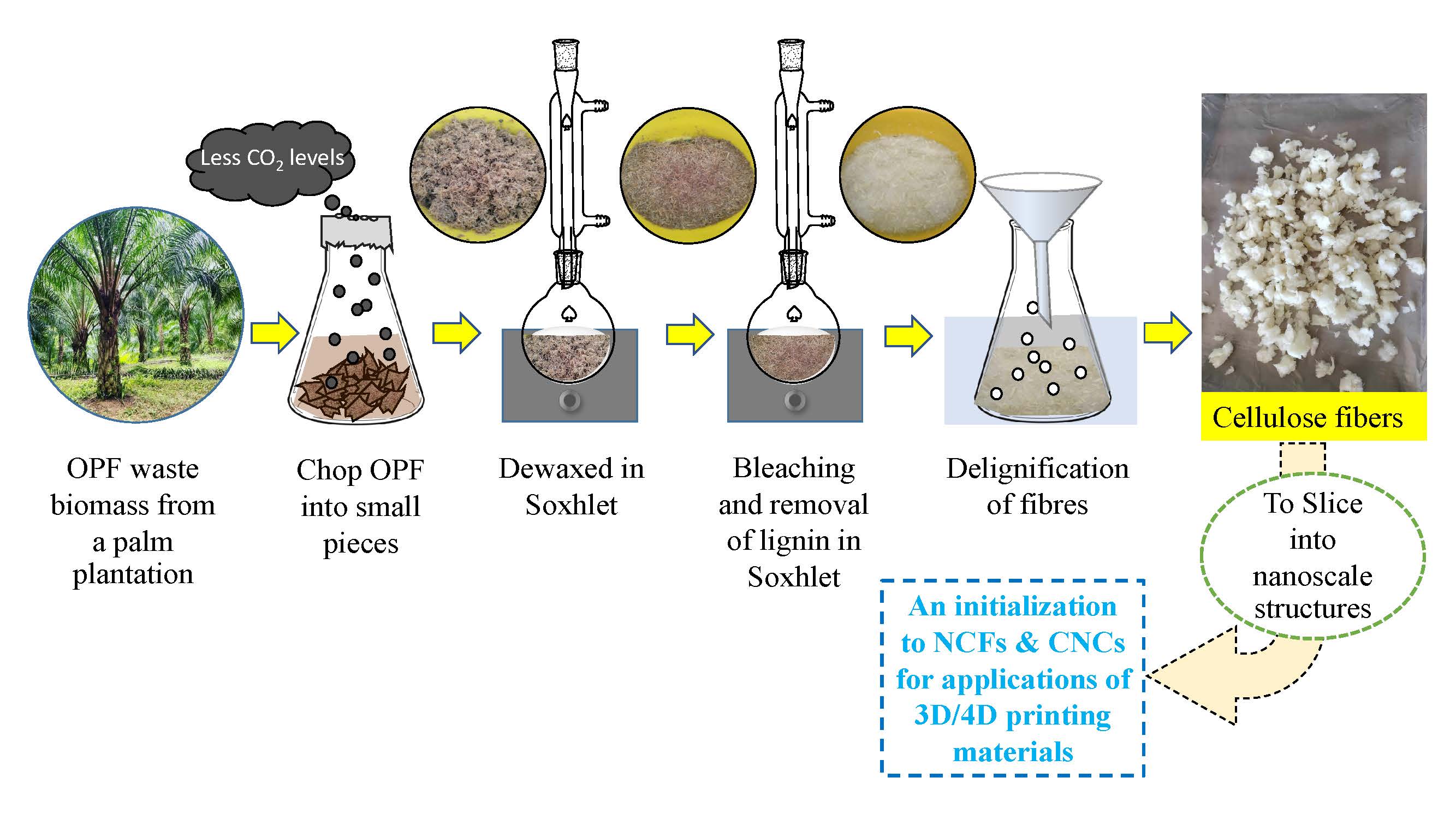Isolation of Fiber-Cellulose and Characterization from Oil Palm Frond for 3D and 4D Printing Materials Application
Main Article Content
Abstract
The oil palm frond (OPF), a primary biomass derived from agricultural waste in oil palm production, holds significant potential for evolving into cellulose fiber. Leveraging natural materials for cellulose extraction aligns with environmental sustainability. In this study, we focus on separating cellulose fibers from OPF biomass. The OPF is divided into its leaflet and frond-axial parts, undergoing a sequence of steps: dewaxing, alkaline treatment, delignification, hydrogen peroxide treatment, and final filtration. These steps assess both efficacy and cellulose fiber outputs. Notably, the axial and leaflet portions yield cellulose fibers, effective as an initial extraction step before progressing to nanoscale slicing. Quantitatively, extraction yields indicate that 14.13% and 19.52% of the 100 g leaflet and frond-axial portions can be harvested. SEM images confirm well-dispersed individual fibers. Additionally, GCMS results reveal slightly higher carbon dioxide gas in the palm leaflet sample than in the palm frond-axial sample after five days of water soaking. This procedure efficiently initializes OPF for cellulose extraction, positioning it as an initial ingredient for subsequent 3D/4D printing material production.
Article Details

This work is licensed under a Creative Commons Attribution-NonCommercial-NoDerivatives 4.0 International License.
References
Roslan, A. M.; Zahari, M. A. K.; Hassan, M. A.; Shirai, Y. Investigation of Oil Palm Frond Properties for Use as Biomaterials and Biofuels. Trop. Agr. Develop. 2014, 58(1), 26–29. https://doi.org/10.11248/jsta.58.26
Wang, Q.; Sun, J.; Yao, Q.; Ji, C.; Liu, J.; Zhu, Q. 3D printing with cellulose materials. Cellulose 2018, 25, 4275–4301. https://doi.org/10.1007/s10570-018-1888-y
Mehanny, S.; Magd, E. E. A-E.; Ibrahim, M.; Farag, M.; Gil-San-Millan, R.; Navarro, J.; Habbak, A. E. H. E.; El Kashif, E. Extraction and Characterization of Nanocellulose from three types of Palm Residues, JMR&T 2021, 10, 526-537. https://doi.org/10.1016/j.jmrt.2020.12.027
Finny, A.S.; Popoola, O.; Andreescu, S. 3D-Printable Nanocellulose-Based Functional Materials: Fundamentals and Applications. Nanomaterials 2021, 11, 2358. https://doi.org/10.3390/nano11092358
Pal, A. K.; Mohanty, A. K.; Misra, M. Additive Manufacturing Technology of Polymeric Materials for Customized Products: Recent Developments and Future Prospective. RSC Advances 2021, 11, 36398 – 36438. https://doi.org/10.1039/D1RA04060J
Guvendiren, M.; Molde, J.; Soares, R. M.D.; Kohn, J. Designing Biomaterials for 3D Printing. ACS Biomater. Sci. Eng. 2016, 2(10), 1679-1693. https://doi.org/10.1021/acsbiomaterials.6b00121
Ahmed, A.; Arya, S.; Gupta, V.; Furukawa, H.; Khosla, A. 4D Printing: Fundamentals, Materials, Applications and Challenges. Polymer 2021, 228, 123926. https://doi.org/10.1016/j.polymer.2021.123926
Kumar, S. B.; Jeevamalar, J.; Ramu, P.; Suresh, G.; Senthilnathan, K. Evaluation in 4D printing – A Review. Materials Today: Proceedings 2021, 45, Part 2. 1433-1437. https://doi.org/10.1016/j.matpr.2020.07.335
Alsaadi, M.; Hinchy, E.P.; McCarthy, C.T.; Moritz, V.F.; Zhuo, S.; Fuenmayor, E.; Devine, D.M. Liquid-Based 4D Printing of Shape Memory Nanocomposites: A Review. J. Manuf. Mater. Process. 2023, 7, 35. https://doi.org/10.3390/jmmp7010035
Dizon, J.R.C.; Gache, C.C.L.; Cascolan, H.M.S.; Cancino, L.T.; Advincula, R.C. Post-Processing of 3D-Printed Polymers. Technologies 2021, 9, 61. https://doi.org/10.3390/technologies9030061
Petousis, M.; Vidakis, N.; Mountakis, N.; Papadakis, V.; Kanellopoulou, S.; Gaganatsiou, A.; Stefanoudakis, N.; Kechagias, J. Multifunctional Material Extrusion 3D-Printed Antibacterial Polylactic Acid (PLA) with Binary Inclusions: The Effect of Cuprous Oxide and Cellulose Nanofibers. Fibers 2022, 10, 52. https://doi.org/10.3390/fib10060052
Khalil, H.P.S.A.; Mohamed, S.A.; Ridzuan, R.; Kamarudin, H.; Khairul, A. Chemical Composition, Morphological Characteristics, and Cell Wall Structure of Malaysian Oil Palm Fibers. Polym. Plast. Technol. Eng 2008, 47, 273–280. https://doi.org/10.1080/03602550701866840
Rosli, W.D.W.; Zainuddin, Z.; Law, K.N.; Asro, R. Pulp from Oil Palm Fronds by Chemical Processes. Ind. Crops. Prod. 2007, 25, 89–94. https://doi.org/10.1016/j.indcrop.2006.07.005
Chen, H.; 4 - Lignocellulose biorefinery conversion engineering. In Lignocellulose Biorefinery Engineering, Chen, H., Eds.; Woodhead Publishing: Amsterdam. 2015, pp. 87-124.
Romruen O.; Karbowiak T.; Tongdeesoontorn W.; Shiekh K.A., Rawdkuen S. Extraction and Characterization of Cellulose from Agricultural By-Products of Chiang Rai Province, Thailand. Polymers 2022, 14(9), 1830. https://doi.org/10.3390/polym14091830
Izani, M.A.N.; Paridah, M.T.; Anwar, U.M.K.; Mohd Nor, M.Y.; H’ng, P.S. Effects of fiber treatment on morphology, tensile and thermogravimetric analysis of oil palm empty fruit bunches fibers. Compos. Part B 2013, 45, 1251–1257. https://doi.org/10.1016/j.compositesb.2012.07.027


